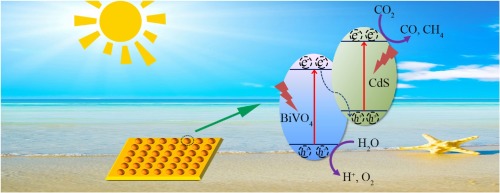Journal of CO2 Utilization ( IF 7.2 ) Pub Date : 2018-09-17 , DOI: 10.1016/j.jcou.2018.09.008 Zhi-He Wei , Yan-Fang Wang , Yan-Yang Li , Lin Zhang , Hong-Chang Yao , Zhong-Jun Li

|
Construction of Z-scheme photocatalysts has drawn much attention in the field of CO2 reduction. However, research on photoreduction CO2 for monoclinic bismuth vanadate (m-BiVO4) is restricted due to its low conduction band potential and short electron diffusion lengths. To address the issues, we herein constructed a series of CdS/BiVO4 nanocomposites by depositing CdS on the surface of BiVO4 coupling with controlling the thickness of BiVO4 nanosheets. The morphological, crystalline, band alignment and optical properties of the samples are investigated intensively. Photocatalytic performance is evaluated by measuring the ability of the photocatalysts to convert CO2 into CO and hydrocarbon fuels, primarily CH4. The composites exhibit more efficient photocatalytic activity than CdS and BiVO4, and the yields of CH4 and CO vary depending on the thickness of BiVO4 substrate. The maximum yields of CH4 and CO for CdS/BiVO4 with 55–75 nm BiVO4 are 2.98 and 1.31 μmol g−1 after 5 h irradiation, while those for its counterpart with 15–30 nm BiVO4 attain 8.73 and 1.95 μmol g−1, respectively. The enhanced photoactivity of the composites is attributed to the band structure and Z-scheme charge transfer mode. Besides, thinner BiVO4 nanosheets are confirmed to be favorable for improving the photoreduction CO2 efficiency due to shorter electron diffusion lengths.
中文翻译:

Z方案CdS / BiVO 4纳米复合材料具有更薄的BiVO 4纳米片增强的光催化CO 2还原活性
Z-方案光催化剂的构造在CO 2还原领域引起了很多关注。然而,单斜晶钒酸铋(m -BiVO 4)的光还原CO 2研究由于其低的导带电势和短的电子扩散长度而受到限制。为了解决这些问题,我们通过在BiVO 4的表面上沉积CdS并控制BiVO 4的厚度,从而构建了一系列的CdS / BiVO 4纳米复合材料。纳米片。对样品的形态,结晶,能带排列和光学性质进行了深入研究。通过测量光催化剂将CO 2转化为CO和烃类燃料(主要是CH 4)的能力来评估光催化性能。该复合材料显示出比CdS和BiVO 4更有效的光催化活性,并且CH 4和CO的产率随BiVO 4底物的厚度而变化。照射5 h后,具有55–75 nm BiVO 4的CdS / BiVO 4的CH 4和CO的最大产率分别为2.98和1.31μmolg -1,而对应的15–30 nm BiVO的CH 4和CO的最大产率为1。图4的样品分别达到8.73和1.95μmolg -1。复合材料增强的光活性归因于能带结构和Z型电荷转移模式。此外,由于较短的电子扩散长度,更薄的BiVO 4纳米片被证实有利于提高光还原CO 2效率。











































 京公网安备 11010802027423号
京公网安备 11010802027423号